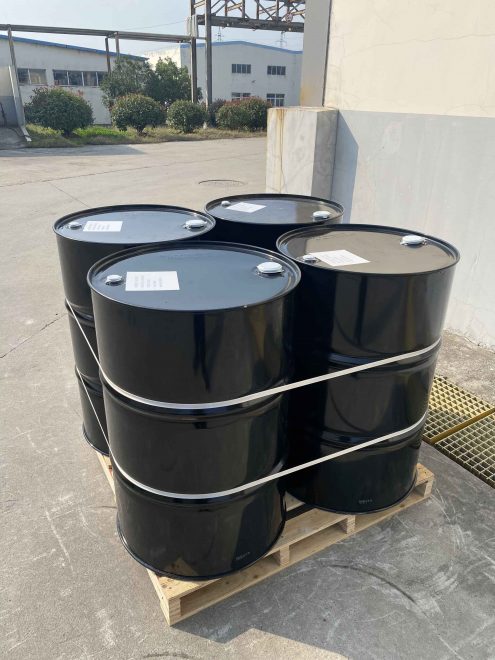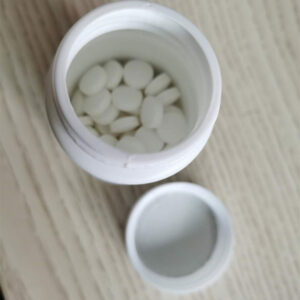Description
2-Amino-2-methyl-1-propanol Detail
Chemical Name: AMP-95 MULTIFUCTION ORGANIC-AMINE AGENT
CAS No.: 124-68-5
Molecular Fomula: C4H11NO
Chemical Structure: 
Molecular weight: 89.14
Appearance: Colorless or light yellow transparent liquid, no mechanical impurities
AMP-95 Typical Properties:
AMP-95 Usage:
1. Various kinds of latex paint
2. Water-based industrial paint
3. Synthetic emulsion
4. Water-based adhesives
Method of use
1 Dosage is 0.1~1.0% of the total weight of the formula.
2 Add 1/3~1/2 of the total amount at the pulping stage, and add the rest at the paint mixing stage.
3 Add it into the water with dispersant at the stage of pulping, and then add pigment filler in turn under rapid stirring after full dissolution. Add pigment filler in turn under rapid stirring
4 At the stage of paint mixing, first dilute it with 2~5 times water, and then add it slowly under stirring.
AMP-95 Packaging:
Packing: 200kg/drum or 1ton/drum
AMP-95 Storage:
Stored in a cool dry place out of direct sunlight and water
Ventilated warehouse, Low-temperature drying.
Contact Us Now!
If you need Price, please fill in your contact information in the form below, we will usually contact you within 24 hours. You could also email me info@longchangchemical.com during working hours ( 8:30 am to 6:00 pm UTC+8 Mon.~Sat. ) or use the website live chat to get prompt reply.
Physical Properties
Physical properties indicate the shape, structure, density, particle size and other properties of the catalyst. They usually include five main items: specific surface area, pore volume, apparent bulk density, wear index, and sieve composition. They are briefly described below:
1、Specific surface area
The specific surface area of catalyst is the sum of internal surface area and external surface area. The internal surface area refers to the surface area inside the micropores of the catalyst, while the external surface area refers to the surface area outside the micropores of the catalyst, and usually the internal surface area is much larger than the external surface area. The surface area per unit weight of catalyst is called specific surface area.
Specific surface area is an important index to measure the performance of catalyst. There is no direct correspondence between specific surface area and activity for different products, due to different carriers and preparation processes.
The method used to determine the specific surface area is nitrogen adsorption capacity method.
2、Pore volume
Pore volume is a physical quantity that describes the pore structure of catalyst. The pore structure not only affects the activity and selectivity of the catalyst, but also influences the mechanical strength, lifetime and heat resistance of the catalyst.
Pore volume is the sum of the volume of micropores in the porous catalyst particles, and the unit is ml/g. The size of the pore volume is mainly closely related to the carrier in the catalyst. For the same type of catalyst, the pore volume decreases while the pore diameter increases during use.
The pore volume is measured by the water drop method.
3. Wear index
An excellent FCC catalyst, in addition to high activity and good selectivity, should also have a certain wear-resistant mechanical strength. A catalyst with poor mechanical strength will not only cause much loss during operation, increase catalyst dosage and pollute the environment, but also seriously damage the reasonable distribution of the catalyst in the dilute and dense phases, and even make the production unit unable to operate.
The size of catalyst wear strength is determined by the type of binder in the preparation process. Usually, the catalyst with aluminium sol as binder has the best strength and the smallest wear index, while the catalyst with fully synthetic silica-aluminium sol as binder has the worst strength and the large wear index.
At present, the ‘wear index’ is used to evaluate the wear strength of microsphere catalysts. The measurement method is as follows: put a certain amount of catalyst into the wear index measuring device, and then blow the catalyst for 5 hours under the constant gas speed, discard the <15μ specimens blown out in the first hour, and then collect the specimens blown out in the next 4 hours, and then calculate the average wear percentage per hour (the percentage of <15μ specimens blown out per hour in the original specimens of the weight of the >15μ portion of the original specimens), and then calculate the wear index of the catalyst in %h-1, and then calculate the wear index in %h-1. The unit is %h-1.
The current method for analysing catalyst wear index is the straight tube method.
4. Particle size distribution (sieving)
FCC catalyst should have good particle size distribution to ensure good fluidisation. It is generally required that no more than 25% of catalyst particles <40μm, no less than 50% of 40μm to 80μm, and no more than 30% of >80μm.
In the fluidised state, the fine powder <20μm produced by the catalyst through abrasion and impact can easily run away from the cyclone separator. Generally speaking, the worse the catalyst abrasion resistance is, the more serious the run-off is. In FCC operation, in order to balance the production, it is necessary to constantly replenish this runaway catalyst. If the catalyst has more fines, is less strong, and has more run-off, then the amount of fresh catalyst needed to be replenished will be greater, and the cost of production will increase. The finer the catalyst particles, the shorter the residence time in the unit; while the coarser catalyst particles have a long residence time in the unit and decay in activity. Therefore, in order to maintain the equilibrium activity level of the device, in addition to replenishing the catalyst of normal runout, appropriate unloading is also very necessary.
At present, the instrument used to determine the sieving of catalyst is laser particle sizer.
5、Apparent bulk density
The size of catalyst density has influence on the fluidisation performance, measurement of fluidised bed, size of equipment and measurement of catalyst. Usually, the density of catalyst is expressed by apparent bulk density, commonly known as stacking specific gravity.
In normal production, the instrument used to analyse the apparent bulk density of the catalyst is a 25 ml measuring cylinder with an inner diameter of 20 mm and cut and ground exactly at the 25 ml scale. Measurement is made by placing the cylinder under a funnel, pouring the sample onto the funnel so that the sample continuously fills the cylinder and overflows within 30 seconds, scraping the excess catalyst with a spatula, wiping the catalyst from outside the cylinder and weighing it. From this the apparent bulk density of the catalyst was calculated. The unit is grams per millilitre.







Reviews
There are no reviews yet.